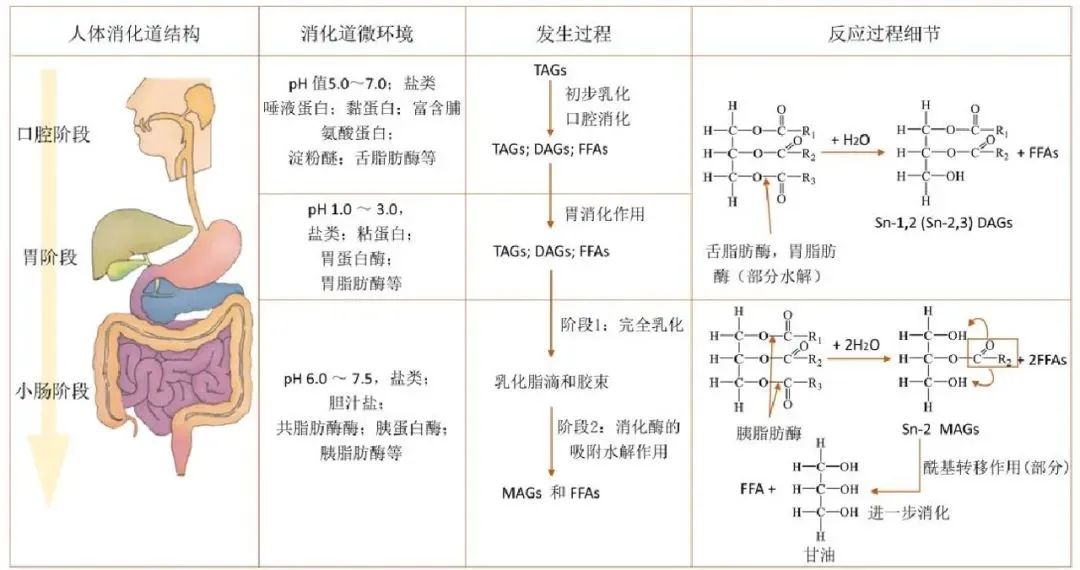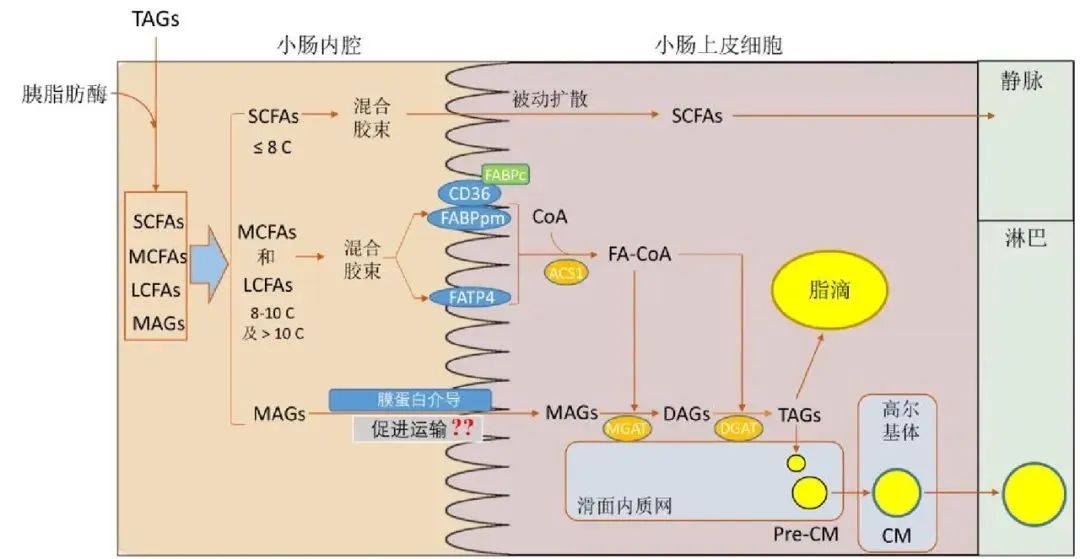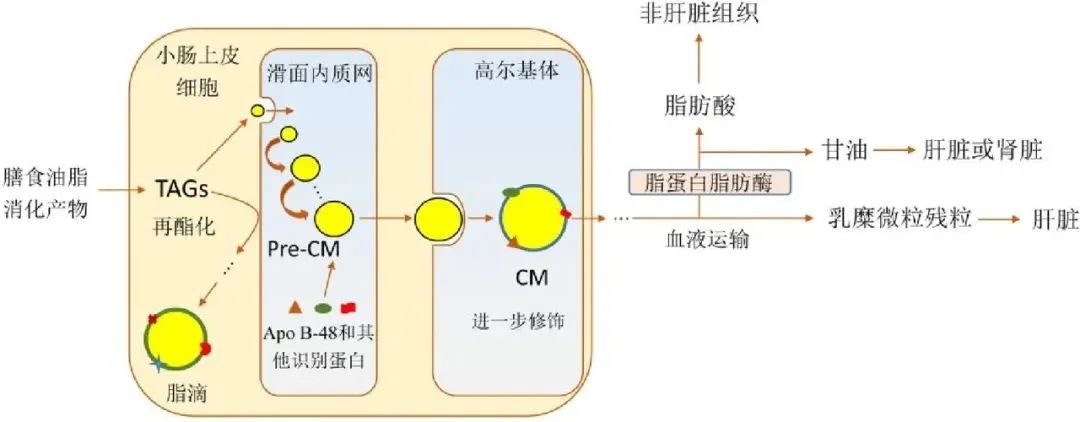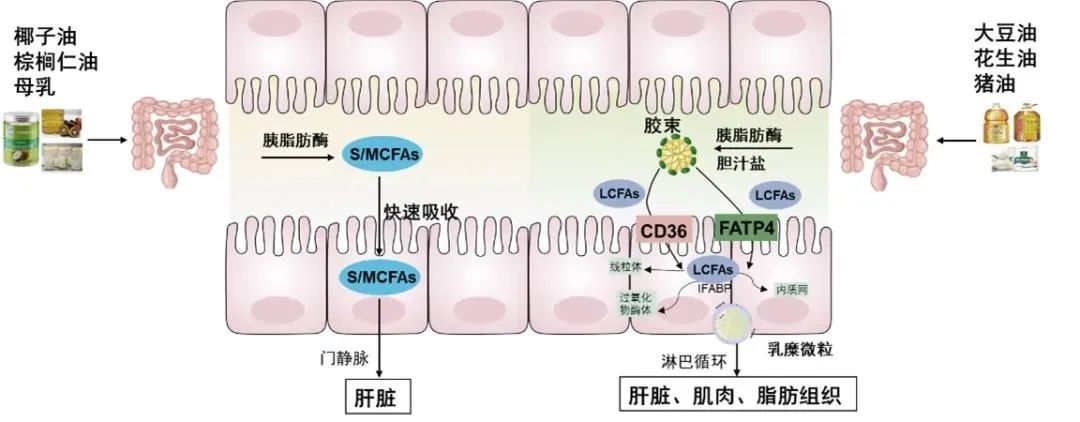Dietary oils and fats are important nutrients ingested by the human body, mainly composed of triglycerides, phospholipids, cholesterol, fat soluble vitamins, etc. As an essential nutrient for the human body, its metabolism and absorption play an important role in the field of nutrition. They play a crucial role in providing energy, building cell membranes, and maintaining various physiological functions in the body. However, due to the insolubility of oil in water, its digestion and absorption processes are relatively complex, requiring multiple physiological steps such as emulsification, enzymatic hydrolysis, transport, intracellular metabolism, and transport to the systemic circulation. The following will provide a detailed analysis of the digestion and absorption process of dietary oils in the intestine.

Schematic diagram of the digestion and absorption process of dietary oils in the intestine
1. The digestion of dietary oils and fats in the gastrointestinal tract
The digestion of dietary oils is divided into oral digestion, gastric digestion, and small intestine digestion processes. Tongue lipase and gastric lipase can hydrolyze short chain triglycerides, which then enter the small intestine and undergo small intestine peristalsis. Under the action of bile acid salts in bile, the oils undergo emulsification. Bile acids are amphiphilic molecules, with one end hydrophilic and the other end hydrophobic. They can break down insoluble fat particles into smaller fat droplets, thereby increasing the contact surface area between lipids and digestive enzymes, which is beneficial for lipid digestion and absorption. After emulsification is completed, pancreatic lipase interacts with other cofactors such as co lipases to hydrolyze triglycerides, breaking them down into 2-monoglycerides and free fatty acids. These lipid products can be absorbed by intestinal epithelial cells. In addition, cholesterol esters and phospholipids are hydrolyzed into free cholesterol and lysophospholipid under the action of cholesterol esterase and phospholipase A2, respectively, thus preparing to enter the absorption stage.

The structure of human digestion and the digestion process of dietary oils in the gastrointestinal tract
2. The absorption of dietary oils and fats in the small intestine
The emulsified lipid products form mixed micelles with bile acids, which can maintain the stability of lipolysis products in the water-soluble environment of the intestine, with small volume and strong polarity. These mixed micelles transfer lipolysis products to the microvilli surface of small intestinal epithelial cells, and the lipolysis products enter the small intestinal epithelial cells through passive diffusion or protein mediated absorption. The specific absorption mechanism varies depending on the type of lipid product (such as SCFA, MSCFA, LCPF, and MAG).
2.1 Absorption of short chain and medium chain fatty acids
Short chain fatty acids (SCFA) and medium chain fatty acids (MCFA), due to their small molecular size and strong water solubility, can enter small intestinal epithelial cells directly through passive diffusion. These fatty acids do not require complex transport processes, they enter the portal vein system directly and are transported to the liver for metabolism. This process is relatively simple and has a high absorption efficiency. Triglycerides composed of short and medium chain fatty acids are emulsified by bile salts and hydrolyzed by lipase in intestinal mucosal cells to form fatty acids and glycerol, which enter the bloodstream through the portal vein.
2.2 Absorption of long-chain fatty acids
The mechanism by which long-chain fatty acids (LCFA) cross the cytoplasmic membrane has been controversial for many years, with the core question being whether this process occurs through passive diffusion or is mediated by proteins. Early research suggested that the uptake of fatty acids by intestinal cells is achieved through passive diffusion processes, not mediated by proteins, but through natural diffusion of concentration differences. However, passive diffusion mechanisms relying solely on concentration gradients cannot fully explain some phenomena, such as cell specificity, high affinity, and selectivity towards different fatty acids during fatty acid uptake. In fact, the specificity and high affinity of fatty acid uptake depend on the synergistic effect of transporters. (1) CD36 transporter: CD36 is one of the key transporters for long-chain fatty acid uptake, located at the brush like edge of the proximal intestinal epithelium. CD36 has a hydrophobic pocket structure, which allows it to bind with LCFA by directing fatty acids to the outer lobes of the cell membrane (i.e. the outer layer of the cell membrane), where they are adsorbed onto the cell membrane surface. Under the action of CD36, the bound long-chain fatty acids undergo translocation or flipping, crossing the cell membrane. Once fatty acids cross the cell membrane, they bind to the fatty acid binding protein (FABP) located in the intracellular region of CD36. The FABP protein is responsible for transporting LCFA to different metabolic sites inside the cell, such as mitochondria, endoplasmic reticulum, peroxisomes, etc., ensuring efficient reuse of fatty acids. (2) Fatty acid transporter 4 (FATP4): FATP4 is located on the intestinal cell membrane and can directly bind to LCFA and transport it into the cell. In addition to transporting fatty acids, members of the FATP family also have the activity of acyl CoA synthase, which can quickly convert LCFA entering the cell into acyl CoA, thereby locking in fatty acids within the cell. FATP4 is a key protein for the transport of long-chain and ultra long chain fatty acids. The possible mechanism is to transport LCFA to the cell membrane through FATP4 and reduce the energy barrier across the LCPF membrane, thereby promoting the diffusion of LCPF. (3) Intestinal fatty acid binding protein (IFABP): Once long-chain fatty acids enter intestinal epithelial cells, they bind to intracellular IFABP and are transported to metabolic sites such as the endoplasmic reticulum, ensuring efficient reuse of fatty acids.
2.3 Absorption of monoglycerides
Monoglycerides (MAG), similar to long-chain fatty acids, form mixed micelles and are transported to the intestinal epithelial cell membrane. They can enter intestinal cells through simple diffusion and assisted by some lipid transporters such as CD36 and FATP4. After entering the cell, MAG will re esterify with LCFA in the endoplasmic reticulum to generate triglycerides (TAG). Some of the newly synthesized TAG will be transferred to the cytoplasm to participate in the synthesis of cytoplasmic lipid droplets and store energy, while others will form chylomicrons and be transported to the lymphatic system to participate in systemic circulation.
2.4 Absorption of cholesterol
The absorption of cholesterol mainly occurs in the epithelial cells of the small intestine, mediated by the cholesterol transporter protein (NPC1L1). NPC1L1 is distributed on the brush border membrane of the small intestine and can efficiently bind dietary cholesterol and cholesterol molecules recovered from bile, transporting them from the small intestinal lumen to intestinal cells. This process is a key step in cholesterol absorption. After cholesterol enters intestinal cells, it can be catalyzed by acetyl CoA cholesterol acyltransferase (ACAT) in the endoplasmic reticulum to produce cholesterol esters, making them easier to package into lipoproteins. Cholesterol esters mainly enter chyle granules (CM), which are responsible for transporting dietary lipids from the intestine to the lymphatic system and then into the bloodstream. Unesterified cholesterol does not convert into cholesterol esters, but can be directly integrated into high-density lipoprotein (HDL) particles and enter the bloodstream.
2.5 Absorption of phospholipids
Phospholipids are important components in diet and bile, and can directly penetrate the intestinal cell membrane and enter cells through simple diffusion. Research has shown that ATP binding cassette transporter B4 (ABCB4) may play a role in the transmembrane transport of phospholipids, but the specific mechanism is not yet fully understood. After entering intestinal cells, phospholipids may bind with fatty acids to form new phospholipid molecules, which further enter the endoplasmic reticulum to synthesize other more complex lipids, such as phosphatidylcholine and phosphatidylethanolamine. The absorbed phospholipids will be added to chylomicrons and transported to the bloodstream through the lymphatic system; The other part can directly form high-density lipoprotein (HDL) particles and enter the bloodstream.
Molecular mechanism of dietary oils and fats during intestinal absorption
3. Metabolism of fatty acids and formation of chylomicrons
Fatty acids in the diet are first emulsified and form micelles. Fatty acids are released from these micelles and enter intestinal epithelial cells through lipid membranes. Long chain fatty acids that enter intestinal epithelial cells are re synthesized into triglycerides in the endoplasmic reticulum (ER). This process is catalyzed by a series of enzymes, especially triglyceride synthase, which plays a key role in the reconstruction of fatty acids and glycerol molecules. In addition to triglycerides, free cholesterol and phospholipids absorbed into cells are also re synthesized in intestinal cells to form the lipids required by the cells. These re synthesized lipid molecules, such as triglycerides, cholesterol, and phospholipids, bind to specific proteins to form chylomicrons. Chylocytes are lipid transport particles containing triglycerides, cholesterol, phospholipids, and fat soluble vitamins. The outer layer is wrapped in a single-layer membrane formed by phospholipids and proteins, which can stably exist in water-soluble plasma. Chylocytes are released into the intercellular spaces of intestinal epithelial cells through exocytosis, and then enter the lymphatic system.
4. Transport of chylomicrons and systemic distribution of fatty acids
After entering the lymphatic system, chylomicrons enter the bloodstream through the thoracic duct and are gradually taken up and utilized by various tissues and organs in the body, especially the liver, muscles, and adipose tissue. In these tissues, lipids in chylomicrons are metabolized, providing the energy needed by cells and serving as an important form of lipid storage.

Transport and metabolic processes of dietary oils and fats after digestion
5. Regulation mechanism and influencing factors of oil absorption
The absorption of dietary oils not only depends on the physiological functions of the digestive system, but is also regulated by various internal and external factors.
5.1 Recovery of bile acids and absorption of fatty acids
Bile acids play an important role in the process of oil absorption, and their effective recovery is the key to ensuring efficient absorption of fatty acids. Bile acids are reabsorbed at the end of the ileum, returned to the liver through the hepatic enteric circulation, and re secreted into the gallbladder to maintain a stable concentration in the digestive tract.
5.2 The regulatory role of hormones
Gastrointestinal hormones such as insulin and glucagon like peptide-1 (GLP-1) are secreted after meals, acting on intestinal epithelial cells and transporters to regulate the absorption and metabolism of fatty acids. In addition, insulin also regulates the intracellular metabolism of fatty acids, promoting their storage in adipose tissue.
5.3 Nutritional and dietary factors
Fiber, protein, carbohydrates, and other micronutrients in the diet have a direct impact on the absorption of fatty acids. For example, high dietary fiber may decrease the absorption rate of fatty acids by increasing the viscosity of intestinal contents and reducing the contact between fatty acids and small intestinal epithelium. In addition, the proportion of polyunsaturated fatty acids in the diet can also affect the efficiency of fatty acid absorption.
5.4 The influence of pathological status on fatty acid absorption
Certain disease states may affect the normal absorption of fatty acids, such as pancreatic dysfunction, bile acid metabolism disorders, or small intestine malabsorption syndrome. These diseases disrupt the processes of emulsification, lipolysis, or transport, leading to impaired absorption of fatty acids and subsequently affecting energy metabolism throughout the body.

6. Conclusion
The absorption of fatty acids is a crucial step in dietary lipid metabolism, involving multiple complex physiological processes and molecular mechanisms. Oil undergoes emulsification, lipolysis, transport, and synthesis in the intestine, ultimately entering the lymphatic system in the form of chylomicrons and being transported to various tissues throughout the body through blood circulation. The absorption process of fatty acids is regulated by multiple factors such as bile acids, transporters, and hormones, while its absorption efficiency is influenced by factors such as dietary composition and pathological status.
References:
[1] Mansbach CM 2nd, Nevin P. Intracellular movement of triacylglycerols in the intestine[J]. J Lipid Res, 1998, 39(5):963-968.
[2] Mu H, Høy CE. The digestion of dietary triacylglycerols[J]. Prog Lipid Res, 2004, 43(2):105-133.
[3] Ko CW, Qu J, Black DD, et al. Regulation of intestinal lipid metabolism: current concepts and relevance to disease[J]. Nat Rev Gastroenterol Hepatol, 2020, 17(3):169-183.
[4] Xiao C, Stahel P, Lewis GF. Regulation of chylomicron secretion: Focus on post-assembly mechanisms[J]. Cell Mol Gastroenterol Hepatol, 2019, 7(3):487-501.
[5] Ye Zhan Research on the Digestive and Absorption Characteristics of Typical Dietary Oils and Their Effects on Intestinal Health [D]. Jiangnan University, 2020
Note: The content of the article is from Lipid Jiangnan. The article is reproduced for learning and communication purposes only. If there are any copyright issues, please contact the author to delete it.